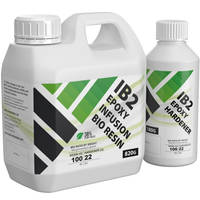Need any help or advice?+44 (0)1782 454499
PRODUCTS USED IN THIS PROJECT
Although not necessarily an exhaustive list, the following tools and materials, supplied by Easy Composites, were used in this project.
The quantity shown below is the approximate amount used in the project rounded up to the nearest available kit size or quantity.
INFUSION EQUIPMENT & CONSUMABLES
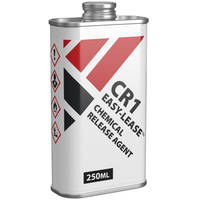
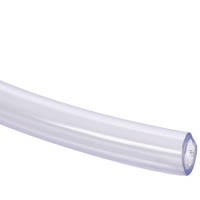


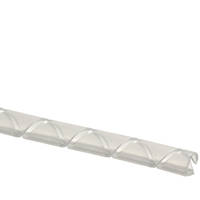
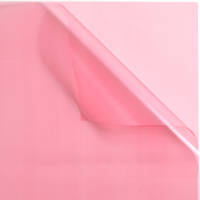

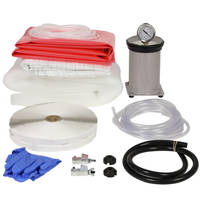
FLAX REINFORCEMENTS
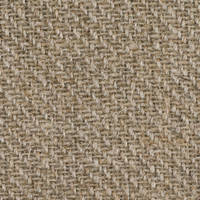
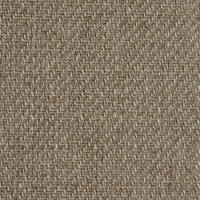

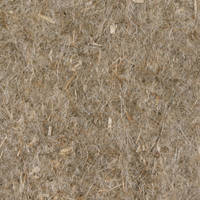

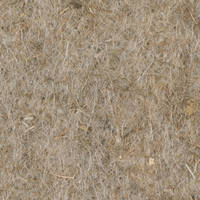
VIDEO TUTORIAL
Flax Fibre Reinforcement in Composites
Discussing the advantages and disadvantages of flax fibre as a reinforcement in composites, suitable applications and practical considerations when working with flax.
In this video we take a closer look at flax fibre and its use in composites. I discuss what flax fibre is and what its advantages and disadvantages are, as well as how to best work with this material, a demonstration of which is provided with the resin infusion of a flax reinforced chair moulding.
Introduction to Flax Fibre
What is Flax Fibre?
Flax is a natural fibre that comes from the stem of the flax or linseed plant, which is grown and harvested specifically for its fibre. Flax fabric, commonly known as linen, has been produced for thousands of years and is in fact the oldest known textile.
What makes this fibre viable as a reinforcement material for us in composites is its long, continuous, cellulose fibres which – for a natural fibre - have excellent tensile strength and stiffness. Although there are other types of natural fibre, such as hemp and jute that can be used, flax generally offers the best mechanical properties of these materials which is why it is the most widely used natural reinforcement in composites.
Advantages and Disadvantages of Flax as a Reinforcement
Sustainable Production
One of the main reasons that flax is increasingly considered for use in composites is the growing emphasis on using more sustainable and environmentally-friendly materials throughout industry. Flax fibre requires between 2 and 5 times less energy to produce per unit weight than glass fibre, and, in fact, carbon emissions from its production are often claimed to be negative, owing to the carbon capture during its growth, so - in markets where customers appreciate or maybe even demand more environmentally conscious products - like outdoor sports and recreation equipment or home goods – flax reinforcement can be a desirable option.
Natural Appearance
When used to produce clear-coated or unpainted laminates, flax has a unique natural appearance. In its unidirectional format, laminated flax fibre looks very similar to wood grain, whereas in its woven format it has a dark brown woven textile appearance, quite different from that of conventional composite reinforcements, such as carbon or glass.
It is worth noting that when flax fibre is wetted out with resin, the colour changes to become considerably darker (as can be seen in the cured laminate sample images on the individual product listings).
Performance of Flax Fibre Compared to Glass Fibre
Flax fibre as a composite reinforcement is not without its compromises. Compared to conventional reinforcements such as glass or carbon fibre, flax does have considerably lower mechanical performance. Weight-for-weight, glass fibre is about four times stronger than flax and carbon fibre is about five times stronger. Stiffness too is similarly compromised.
Inevitably, this reduced mechanical performance does mean that at least some of the environmental benefit from the more sustainable production is negatively offset by the increased resources required to make and use a heavier component meaning that there is certainly a balance to be considered.
How to Work with Flax Fibre
Flax fibre can be used as a composite reinforcement is much the same way as more conventional reinforcements such as glass fibre and carbon fibre, however there are some differences in how the material behaves and is best processed.
Suitable Laminating Methods
Flax fibre can be used on its own or alongside other reinforcements in any laminating method, including hand layup, vacuum bagged hand layup, compression moulding, resin infusion and RTM. Flax reinforcement is also available (in limited formats) as a prepreg reinforcement for oven/autoclave cure.
In the case of open mould hand layup, the ‘springiness’ of flax fibre makes it difficult to laminate flax into more complex mould contours without the reinforcement bridging in corners and also results in quite a high resin uptake as the fibre ‘swells’ resulting in a higher resin content and reduced performance. For this reason, hand layup laminates are best vacuum bagged after lamination to ensure good consolidation and mould contact, and improved fibre fraction.
Suitable Resin Systems
Flax can be used with any conventional composites resin system, including epoxy, polyester and vinylester. Although polyurethane resins are rarely used as a laminating resin matrix, polyurethane resins should be avoided due to their moisture sensitivity.
High bio-based laminating epoxy or bio-based infusion epoxy make obvious choices when working with flax reinforcement due to their reduced environment footprint.
Thickness and Resin Uptake
Flax fibre makes for a particularly low density reinforcement and has a high resin uptake meaning that laminates will be considerably thicker, for a given weight of reinforcement, than would be expected for carbon or glass fibre.
In an open layup without any vacuum bag or press consolidation, flax will tend to swell and consume unnecessary resin meaning that to avoid excessive resin uptake, some form of positive pressure consolidation is highly preferable.
Typical fibre-to-resin ratio in a resin infused woven flax laminate will be 33% flax /66% resin (1:2 fibre ratio).
Typical resin infused laminate thickness for the various weights of woven flax are as follows:
200gsm = 0.44mm
300gsm = 0.65mm
550gsm = 1.2mm
Moisture Content
One consideration when working with flax is its moisture content. Like other natural materials, such as wood, flax fibre will absorb moisture from the air, increasing its moisture content. High moisture content in the fibre can affect its mechanical performance, react with the resin matrix and also cause off-gassing (boiling off) of the moisture under vacuum.
Where flax has been or may have been exposed to relatively high humidity, its moisture content can be reduced by oven drying or alternatively, when processing by resin infusion, a vacuum can be pulled and maintained on the dry laminate for several hours before infusion in order to boil off moisture in the reinforcement.
Resin Infusion
Vacuum resin infusion is one of the most practical and effective ways to manufacture flax fibre mouldings. The advantages of resin infusion when working with flax are good mould conformity, good consolidation (leading to higher fibre fraction) and the ability to vacuum dry the flax before infusion (see Moisture Content above).
Due to the excellent resin flow characteristics, woven flax can be infused without the need for a flow media (infusion mesh), reducing the consumables used in the process. The same would not be true for unidirectional reinforcement where - much like undirectional glass or carbon - resin flow is more restricted by the closely packed fibres, and therefore would still require an infusion mesh.
Available Formats of Flax Fibre
Easy Composites are the exclusive distributors of Eco-Technilin flax fibre reinforcement products in the UK and also sell these materials throughout the EU from our warehouse in the Netherlands and also worldwide through our export sales from the UK. Eco-Technilin are Europe’s largest manufacture of flax reinforcement products with a wide range of flax reinforcement formats available, including unidirectional, woven, non-woven, and even prepreg reinforcements available.
Unidirectional Tapes
These 100% unidirectional flax fibre reinforcements have no weaving or cross stitch and rely only on a lightweight binder to stabilise them. Visually, this results in a pure and simple appearance which is very similar to woodgrain, but does result in a more delicate reinforcement which is better suited to flat laminates. This type of unidirectional reinforcement is supplied in 400mm wide tapes and is available in 50, 110 and 200gsm weights.
Cross-Stitched Unidirectional Tape
In addition to the unsupported undirectional tapes, flax reinforcement is also available in a cross-stitched undirectional format which uses a light woven cross stitch to stabilise the fibre into a more drapable and easy-to-handle material. This cross-stitched UD reinforcement is available in 1000mm width at 180gsm weight.
Woven Flax Fibre
One of the most conventional formats for flax fibre reinforcement is a woven cloth. Woven flax works just like any other woven reinforcement, it is easy to handle and offers a good degree of drapeability.
Prepreg Flax
FLAXPREG is an uncured flax reinforced prepreg, meaning that the epoxy resin matrix has already been impregnated into the flax fibre, much like any other type of prepreg reinforcement. FLAXPREG is currently only available in 400mm width, 110gsm weight unidirectional format.
Non-Woven Flax Fibre Mat
These non-woven mats have a randomly oriented fibre structure resulting in a felt-like mat that is best suited to compression moulding. This type of non-woven flax mat is already used in volume production for non-structural components like automotive door-liners and parcel shelves.
DISCUSSION (10)
Please share any questions or comments you may have about this video tutorial.
I'm sure there would be different combinations of materials that could be used alongside flax in order to alter, and potentially improve, the acoustic properties of the laminate when used as a speaker enclosure. It's very difficult to say exactly what those materials or alternative construction might be because it would depend on the shape, size, strength requirements and lots of other factors and so, as much as I'd like to give a clear recommendation, it would really be a case of experimenting with different material combinations until you find the properties you're looking for.
There would be no difficulty combining most of our flax materials with other materials, such as plywood, MDF, woven glass, carbon fibre etc. The other reinforcements can all be wet-laid, or vacuum bagged, or infused together with the flax, in different ratios, or you could construct from MDF or plywood and then apply layers of flax onto the construction for some damping properties. It's definitely a case of experimentation.
Hi Antica, no problem. The darkening you're seeing is just the normal appearance change when materials with complex surfaces (which makes them look lighter) get wetted out. When you manage to achieve a lighter appearance, it's because you're not properly wetting out the reinforcement. Think of flax (or Jute) just like blond hair, when it's wet, it looks a lot darker. I'm afraid that there isn't really much that can be done about the darkening of the flax when it's wetted out, without compromising the mechanical properties by limiting the wetting out of the fibres.
Hi Logan, you can certainly use re-usable polypropylene containers as your resin bucket. Epoxy won't stick to PP at all so this is a good option; just let it cure and then knock it out. Cured silicone won't affect the curing of epoxy in any way but you will find that epoxy quickly degrades silicone (you'll see it within a few uses) and so, give the cost and bulk involved in any kind of silicone container, you'd be much better of sticking with PP or PE.
Hi Jeff, yes, you could include flax in the reinforcement mix for a surfboard. It does get used in sports equipment like skis and snowboards for its vibration damping properties too and so these properties might bring something to the feel of a surfboard too. Some research and testing might be necessary to ensure that the fibre bundles are fully saturated by the infusion process so as to ensure that they're not 'dry' in the middle, otherwise water ingress into the fibre might be a concern in the event of a ding. I'm not aware of much knowledge or information existing in this area so you might have to pioneer it! As a starting point, using the lightest weight flax fabric possible would help to ensure full wet-out. We have a 200gsm twill flax fabric which uses a very fine thread but the UD flaxes go right down to 50gsm unidirectional flex reinforcement.
Hi Kev, no, we've only had limited experience with basalt fibre. It is indeed suggested as a more eco-alternative to glass fibre but, as with all these things, there's quite a bit to consider 'in the round' in terms of whether it offers real advantages. Maybe one for us to take a closer look at in the future video!
Hi Fredy, yes, the performance of flax will come as a shock if you're expecting its properties and behaviour to be closer to glass fibre (as you sometimes see it, rather misleadingly, compared to). It's still an interesting material and reinforcement but we tend to find that combining it with other types of reinforcement (like we did in our flax and pallet wood skateboard tutorial a few years ago) is a more practical way to work with it.
These materials and this process wouldn't be intended to compete with basic, mass produced injection mouldings. In the video we tried to allude to the complexity of evaluating environmental impact of materials (including 'greener' materials) in the overall lifecycle of a product, there's an awful lot to balance out but no, I would say that for a basic, mass produced, these materials and this production process wouldn't be greener and certainly wouldn't be cheaper. That doesn't mean that there wouldn't be applications where it would or could be, for example an injection moulding tool would be hundreds of times the cost of the composite mould we made (in a single day, for about £50/$70) for this video, and so applications where you're only amortising the cost of the tooling over low production volumes then a composite moulding process would be much lower cost (and less environment impact) than an injection moulding.
Hi Ryan, indeed it does look like hemp fibre does have good potential as a natural reinforcement. We've read papers which have demonstrated hemp fibre yielding better mechanical results than flex fibre but, as far as we've seen, this is only with lab-scale produced hemp fibre which has been specially prepared and conditioned so as to retain and optimise its mechanical properties for composites. As yet (again, to the best of our knowledge) hemp fibre, mass produced in the traditional way, does not retain its mechanical advantage over mass produced flax fibre, but if the lab production techniques are successfully scaled up then it could do, so it's a space worth watching.
The high resin uptake and naturally low compressive strength of flax makes it particularly unsuitable as a core material. Either it's fully wetted-out, in which case it would have great compressive strength (from the cured resin) but would be very dense (almost the same density of the resin) or it remains at least partially 'dry' in which case the compressive strength is very low. There are however natural materials that make fantastic core materials, like balsa wood and cork.
Hemp fibre has good potential as a natural reinforcement but the conventional hemp fibre that's produced in volume doesn't beat the flax that's produced in volume. Various papers have demonstrated hemp fibre yielding better mechanical results than flax fibre but, as far as we've seen, this is only with lab-scale produced hemp fibre which has been specially prepared and conditioned so as to retain and optimise its mechanical properties for composites. As yet (again, to the best of our knowledge) hemp fibre, mass produced in the traditional way, does not retain its mechanical advantage over mass produced flax fibre, but if the lab production techniques are successfully scaled up then it could do, so it's a space worth watching.
More broadly though, as a statement, your internal alarm bells should already be ringing when you read something like "hemp fibres are up to eight times stronger than linen"; differences of this magnitude are pretty unlikely to exist for any similar materials, outside of very specific contexts and conditions.
LEAVE A COMMENT OR QUESTION
PRODUCTS USED IN THIS PROJECT
Although not necessarily an exhaustive list, the following tools and materials, supplied by Easy Composites, were used in this project.
The quantity shown below is the approximate amount used in the project rounded up to the nearest available kit size or quantity.
INFUSION EQUIPMENT & CONSUMABLES








FLAX REINFORCEMENTS






DISCUSSION (10)
Please share any questions or comments you may have about this video tutorial.
I'm sure there would be different combinations of materials that could be used alongside flax in order to alter, and potentially improve, the acoustic properties of the laminate when used as a speaker enclosure. It's very difficult to say exactly what those materials or alternative construction might be because it would depend on the shape, size, strength requirements and lots of other factors and so, as much as I'd like to give a clear recommendation, it would really be a case of experimenting with different material combinations until you find the properties you're looking for.
There would be no difficulty combining most of our flax materials with other materials, such as plywood, MDF, woven glass, carbon fibre etc. The other reinforcements can all be wet-laid, or vacuum bagged, or infused together with the flax, in different ratios, or you could construct from MDF or plywood and then apply layers of flax onto the construction for some damping properties. It's definitely a case of experimentation.
Hi Antica, no problem. The darkening you're seeing is just the normal appearance change when materials with complex surfaces (which makes them look lighter) get wetted out. When you manage to achieve a lighter appearance, it's because you're not properly wetting out the reinforcement. Think of flax (or Jute) just like blond hair, when it's wet, it looks a lot darker. I'm afraid that there isn't really much that can be done about the darkening of the flax when it's wetted out, without compromising the mechanical properties by limiting the wetting out of the fibres.
Hi Logan, you can certainly use re-usable polypropylene containers as your resin bucket. Epoxy won't stick to PP at all so this is a good option; just let it cure and then knock it out. Cured silicone won't affect the curing of epoxy in any way but you will find that epoxy quickly degrades silicone (you'll see it within a few uses) and so, give the cost and bulk involved in any kind of silicone container, you'd be much better of sticking with PP or PE.
Hi Jeff, yes, you could include flax in the reinforcement mix for a surfboard. It does get used in sports equipment like skis and snowboards for its vibration damping properties too and so these properties might bring something to the feel of a surfboard too. Some research and testing might be necessary to ensure that the fibre bundles are fully saturated by the infusion process so as to ensure that they're not 'dry' in the middle, otherwise water ingress into the fibre might be a concern in the event of a ding. I'm not aware of much knowledge or information existing in this area so you might have to pioneer it! As a starting point, using the lightest weight flax fabric possible would help to ensure full wet-out. We have a 200gsm twill flax fabric which uses a very fine thread but the UD flaxes go right down to 50gsm unidirectional flex reinforcement.
Hi Kev, no, we've only had limited experience with basalt fibre. It is indeed suggested as a more eco-alternative to glass fibre but, as with all these things, there's quite a bit to consider 'in the round' in terms of whether it offers real advantages. Maybe one for us to take a closer look at in the future video!
Hi Fredy, yes, the performance of flax will come as a shock if you're expecting its properties and behaviour to be closer to glass fibre (as you sometimes see it, rather misleadingly, compared to). It's still an interesting material and reinforcement but we tend to find that combining it with other types of reinforcement (like we did in our flax and pallet wood skateboard tutorial a few years ago) is a more practical way to work with it.
These materials and this process wouldn't be intended to compete with basic, mass produced injection mouldings. In the video we tried to allude to the complexity of evaluating environmental impact of materials (including 'greener' materials) in the overall lifecycle of a product, there's an awful lot to balance out but no, I would say that for a basic, mass produced, these materials and this production process wouldn't be greener and certainly wouldn't be cheaper. That doesn't mean that there wouldn't be applications where it would or could be, for example an injection moulding tool would be hundreds of times the cost of the composite mould we made (in a single day, for about £50/$70) for this video, and so applications where you're only amortising the cost of the tooling over low production volumes then a composite moulding process would be much lower cost (and less environment impact) than an injection moulding.
Hi Ryan, indeed it does look like hemp fibre does have good potential as a natural reinforcement. We've read papers which have demonstrated hemp fibre yielding better mechanical results than flex fibre but, as far as we've seen, this is only with lab-scale produced hemp fibre which has been specially prepared and conditioned so as to retain and optimise its mechanical properties for composites. As yet (again, to the best of our knowledge) hemp fibre, mass produced in the traditional way, does not retain its mechanical advantage over mass produced flax fibre, but if the lab production techniques are successfully scaled up then it could do, so it's a space worth watching.
The high resin uptake and naturally low compressive strength of flax makes it particularly unsuitable as a core material. Either it's fully wetted-out, in which case it would have great compressive strength (from the cured resin) but would be very dense (almost the same density of the resin) or it remains at least partially 'dry' in which case the compressive strength is very low. There are however natural materials that make fantastic core materials, like balsa wood and cork.
Hemp fibre has good potential as a natural reinforcement but the conventional hemp fibre that's produced in volume doesn't beat the flax that's produced in volume. Various papers have demonstrated hemp fibre yielding better mechanical results than flax fibre but, as far as we've seen, this is only with lab-scale produced hemp fibre which has been specially prepared and conditioned so as to retain and optimise its mechanical properties for composites. As yet (again, to the best of our knowledge) hemp fibre, mass produced in the traditional way, does not retain its mechanical advantage over mass produced flax fibre, but if the lab production techniques are successfully scaled up then it could do, so it's a space worth watching.
More broadly though, as a statement, your internal alarm bells should already be ringing when you read something like "hemp fibres are up to eight times stronger than linen"; differences of this magnitude are pretty unlikely to exist for any similar materials, outside of very specific contexts and conditions.
LEAVE A COMMENT OR QUESTION
100% SECURE
PAYMENT METHODS


Easy Composites Ltd, registered in England 7486797. All content copyright (C) Easy Composites Ltd, 2025. All rights reserved.
